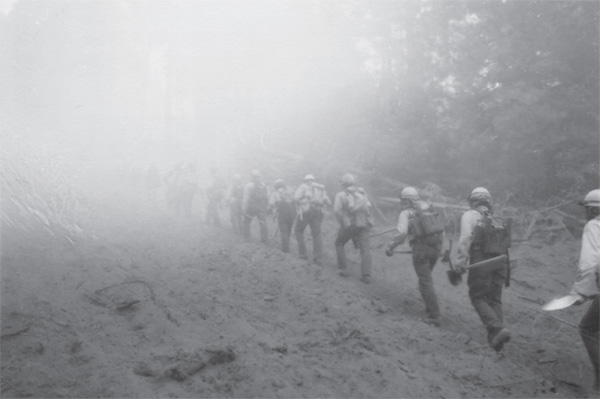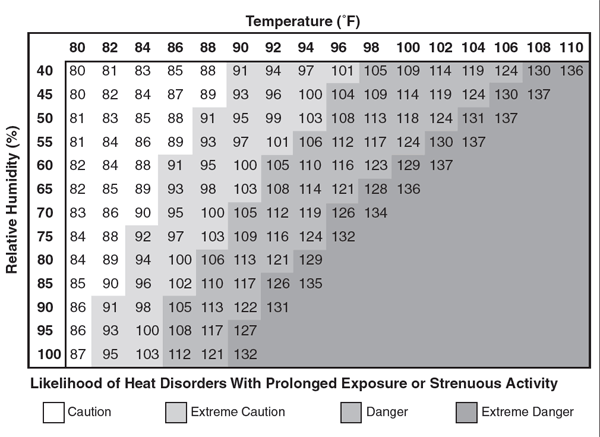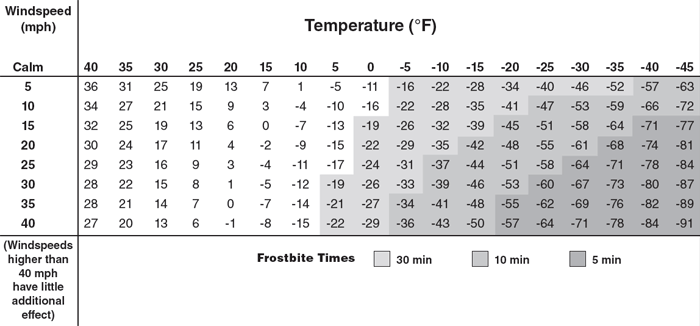Chapter 11—Environment a and Performance

"No athlete is crowned but in the sweat of his brow."
St. Jerome
A number of environmental factors influence work output. This chapter focuses on heat stress, altitude, and smoke, the ways these factors affect performance and health, and what firefighters can do to minimize their impact.
Wildland firefighting is hot, physically demanding work, so it is vital that you understand heat illnesses, how they affect you, and what you can do to prevent or treat them.
Field workers suffer heat stress when the air temperature, humidity, radiant heat, and lack of air movement combine with hard work and protective clothing to raise the body temperature (figure 11.1). Evaporation of sweat is the body's main line of defense against heat. As sweat evaporates, it cools the body. When water lost by sweating is not replaced, the body's heat controls break down and body temperature climbs dangerously. When our bodies can't cope with this added heat, we experience heat illnesses, including heat cramps, heat exhaustion, and heat stroke.

Figure 11.1—Heat index. Locate temperature (top) and relative humidity (side). Intersect
readings
to find the apparent temperature, what the temperature feels like.
(National Weather Service)
Heat Cramps—Painful muscle cramps sometimes strike workers who perform prolonged strenuous effort in the heat. Treatment involves electrolyte drinks (tomato juice, sport drinks, lightly salted water) or electrolyte tablets and stretching to relieve the cramps. The risk is minimized when fluid intake is adequate, when sport drinks are available to replace electrolytes lost in sweat, and when the diet includes bananas, oranges, and salt (sodium) with meals.
Heat Exhaustion—This disorder is characterized by weakness; fatigue; dry, hot, and flushed skin; headache; nausea; and, sometimes, collapse. Heat exhaustion is caused by inadequate fluid intake, sodium depletion, or both. Fluid loss leads to a drop in blood volume that severely limits the muscles' work capacity. Treatment includes rest in a cool place with legs elevated and electrolyte drinks. Prevention includes improved aerobic fitness and acclimation to the heat.
Heat Stroke—Most persons experiencing heat stroke have sweat-soaked and pale skin, hyperthermia (body temperature above 104 degrees Fahrenheit), and central nervous system disturbances. When metabolic heat produced by muscles outpaces the body's ability to dissipate the heat, the core temperature rises to levels that disrupt organ function. The symptoms of heat stroke include disorientation, confusion, dizziness, irrational or unusual behavior, inappropriate comments, and loss of balance and muscle function.
Heat stroke is a life-threatening medical emergency that requires immediate cooling of the whole body. The most rapid cooling involves immersion in cold or ice water. Ice packs, mists, and fanning are less effective than immersion. The patient should be monitored during initial treatment, transport, and medical treatment. Following recovery, the worker should refrain from exercise for at least 1 week. When workers are cleared for a return to activity they should begin gradually, allowing 2 weeks to acclimate and 2 to 4 weeks of training before returning to work.
Hydration
Fluid needs vary from person to person and change with environmental stress. Wildland firefighters should drink enough water throughout the day to maintain their body weight within 2 percent of their weight before beginning work. The U.S. Army and the American College of Sports Medicine recommend drinking up to 1 liter (1.06 quarts) of fluid for every hour of hard work to maintain blood volume and to enhance the body's ability to keep cool by sweating.
How to Stay Hydrated
Before work: 1 to 2 cups of fluid
During work: 1 cup every 15 minutes (1 quart per hour)
After work: Replace fluid deficit
Monitor your body weight to determine fluid deficit. Drink 2½ cups of fluid for each pound of weight loss.
For information on heat and hydration, see Wildland Firefighter Health and Safety Report No. 3 (Sharkey 2000a).
Wildland firefighting generates about 400 kilocalories of heat per hour, with another 180 kilocalories of heat being generated by the environment and the fire (400 + 180 = 580 kilocalories of heat gain per hour). Complete evaporation of 1 liter (1.06 quarts) of sweat removes 580 kilocalories of heat.
There are wide individual differences in sweat rate and fluid loss. Daily fluctuations in weight can be monitored (monitor hydration by weighing in the morning after urinating and before eating or drinking).
Urine Color
In a series of studies, Dr. Lawrence Armstrong confirmed the relationship of urine color to measures of hydration. Urine that is pale yellow or straw color indicates hydration, but darker colors indicate dehydration (Armstrong 2000).
Electrolytes are minerals (such as sodium and potassium) that are important for nerve and muscle function, and for the body's fluid and acid/base balances.
To replace electrolytes lost in sweat:
- Use the saltshaker at meals.
- Eat salty foods (pickles, olives, jerky) when you're sweating during work.
- Drink carbohydrate/ electrolyte drinks (sport drinks) during work.
- Drink milk at breakfast or after work.
Sport Drinks—Carbohydrate/electrolyte drinks (sport drinks) help maintain blood glucose, work output, immune function, improved mood, and the ability to make decisions. The electrolytes help to maintain blood volume. Lightly flavored sport drinks encourage drinking. For more information on sport drinks, see Wildland Firefighter Health and Safety Report No. 8.
Preventing Heat Stress
While it's important to know how to recognize and treat heat disorders, it's best to prevent them. Your actions in the months, weeks, and days before exposure to heat stress are as important as anything you do when you are being stressed.
Fitness—Achieving and maintaining a high level of aerobic fitness is one of the best ways to protect yourself against heat stress.
- The fit worker has a well-developed
circulatory capacity, as well as
increased blood volume.
Both are essential to
regulate body temperature
in the heat.
- Fit people start to sweat at
a lower body temperature,
so they have a lower body
temperature and heart rate
while working.
- Fit workers adjust or
acclimate to work in the
heat twice as fast as unfit
workers (in 4 days
compared to 8). Fit
workers lose acclimation
more slowly and regain
acclimation more quickly
than unfit workers.
- Unfit, overweight workers are unsuited for work in the heat. They carry more weight and don't have a corresponding increase in surface area for evaporative cooling.
Fittest Workers
In a study conducted in the University of Montana Human Performance Laboratory's heat chamber, the fittest worker finished a 2- hour work test with a heart rate of 118 beats per minute, while the least fit labored at a rate of 164 beats per minute. All subjects were working at the same rate and grade on the treadmill. There was a highly significant inverse relationship between aerobic fitness and the working heart rate (r = -0.91).
Acclimation—The worker who is acclimated to work in the heat runs less risk of heat stress. The body adjusts to hot work in 4 to 8 days by:
- Starting to sweat at a lower body temperature
- Increasing sweat production
- Decreasing skin and body temperature
- Improving blood distribution
- Decreasing heart rate
About 1½ hours of work a day is enough to acclimate workers to a specific combination of work and heat, providing partial acclimation for more severe conditions. Fitness training activities also provide partial acclimation. Adjust to hot weather activity gradually. Set a sensible pace, take frequent breaks, replace fluids, and don't expect full production for the first several days.
Acclimation persists for several weeks, especially with regular physical training. Fatigue, sleep loss, and alcohol consumption lead to some loss of acclimation.
Work Habits
Pace yourself. Be aware that individuals may have large differences in heat tolerance. If you push too hard to keep up with others, you may not last the whole work shift. When possible:
- Avoid working close to heat sources.
- Do the hardest work during cooler morning or evening hours.
- Change tools or tasks to minimize fatigue.
- Take frequent short (30-second) rest breaks.
Individual Differences
Individuals differ in their response to heat. Some will always be at greater risk for heat disorders because of inherited differences in heat tolerance (such as perspiration rate, variations in body composition, nutrition, hydration, or fatigue). Illness, drugs, and medications also can influence your body's response to work in a hot environment. If you are using medications or have medical conditions, ask your physician whether they pose a threat. Monitor your response to heat and watch out for signs of heat stress. When possible, weigh yourself in the morning (after urinating, but before breakfast) to watch for dehydration. If your weight is down, rehydrate before you return to work. Take your heart rate when you wake up to see if you are dehydrated, overtired, or have a fever. A heart rate 10 percent above your average could indicate a problem. Finally, always work or train with a buddy who can provide help if you become disoriented or disabled with a heat disorder.
Rest Periods—Work/rest cycles must be adjusted to prevent progressive fatigue. Shorter work periods and frequent rest periods in a cool, shaded area minimize heat buildup. Experience shows that heat stress is unlikely when your heart rate is less than 100 beats per minute after 3 minutes of rest.
Protective Clothing—Modern fire resistant garments, designed to protect against sparks, embers, and brief exposure to direct flame, do so at a price in terms of heat stress. The fabric that provides protection reduces airflow and evaporative cooling. Wear cotton T-shirts and underwear to help sweat evaporate. Do not wear synthetic undergarments. They can melt on your skin when exposed to flame or intense heat. Wear loose-fitting garments to enhance air movement. Avoid extra layers of clothing that insulate and restrict air movement, because they can contribute to heat stress.
Exposure to low temperatures and high winds can lead to frostbite, hypothermia, and even death. The body cuts off blood flow to the extremities when you're cold, leading to discomfort and loss of dexterity. Shivering helps maintain body temperature, but physical activity using large muscles is far more effective than shivering in restoring heat and blood flow. Because large muscle activity takes considerable energy, anyone exposed to cold weather must maintain a reserve of energy for prolonged work and to meet unforeseen emergencies. Excessive fatigue is the first step on the road to hypothermia and possible death.
Windchill—Windchill describes the effect of windspeed on heat loss (figure 11.2). A 10-degree Fahrenheit reading is equivalent to -25 degrees Fahrenheit when the windspeed is 20 miles per hour. If you must face the wind on a cold day, be sure to cover exposed flesh and be on the lookout for frostbite.
Frostbite—Frostbite is damage to the skin from cold exposure. The skin appears pale and feels numb. Rewarm frostbitten skin with warm (not hot) water, but do not massage. Protect sensitive areas (nose, ears, and toes) to avoid frostbite and the pain that occurs during rewarming.

Figure 11.2—Wind chill chart (National Oceanic and Atmospheric Administration 11/01/01).
Hypothermia begins when the body loses heat faster than it can be produced. The problem can be compounded by fatigue, energy depletion, and rapid cooling from snow, rain, wind, and evaporation. When the brain itself cools, the body begins to shut down. This is a medical emergency and the victim should be transported to a medical facility as quickly as possible. Hypothermia often occurs at temperatures above 30 degrees Fahrenheit.
To avoid problems during cold weather:
- Dress in layers, wearing wicking garments underneath a weatherproof parka.
- Take layers off as you heat up and put them on as you cool off.
- Wear a hat that protects your ears.
- Maintain your energy level and avoid exhaustion.
- Acclimate to the cold to minimize discomfort.
While cold air will not freeze tissues in the lungs, even at subzero temperatures, it may make vigorous exercise difficult for those prone to airway constriction. Slow down and use a mask or scarf to minimize the effect of cold air on airways.
Field work and firefighting often take place at moderate altitude. Elevations below 5,000 feet (1,500 meters) have little noticeable effect on healthy workers. But at elevations above 5,000 feet, available levels of atmospheric oxygen decline. With less oxygen available, altitude always reduces work capacity. Even highly fit workers will be affected by the diminished oxygen supply.
Altitude Acclimation
Altitude affects our ability to take in, transport, and use oxygen. Work at altitude leads to acclimation by:
- Increased air intake (better ventilation)
- Improved oxygen transport (increase in red blood cells)
- Improved utilization of oxygen in muscles (increased capillaries)
These adjustments reduce—but never eliminate—the effect of altitude on aerobic fitness. While it takes several weeks to make a good adjustment to work at a higher elevation, athletes have learned that they can improve with a week of altitude training for every 1,000 feet (300 meters) above 5,000 feet elevation.
If your crew works at an elevation above 5,000 feet, take it easy for the first few days, Take frequent breaks and avoid excessive fatigue. Plan more time to recover after hard work. Eat lots of carbohydrates for added energy. Take special care to maintain hydration because altitude hastens fluid loss. As with heat stress, individuals differ in altitude tolerance. Above 8,000 feet (2,400 meters), a few workers may begin to experience mild symptoms of acute mountain sickness (AMS), characterized by headache, fatigue, and lack of appetite. They will require more time to adjust, possibly including recovery time at a lower elevation.
Concern for the health hazards of smoke from prescribed fires and from wildfires is longstanding. The 1987-1988 fire seasons intensified interest and prompted study of the problem. The increasing intensity of fires has contributed to concerns regarding the health hazards of smoke.
Employee Exposure
Studies of air samples collected from the breathing zone of wildland firefighters and workers involved with prescribed burning indicate some potential for hazardous exposure to respirable particulate, carbon monoxide, formaldehyde, and acrolein (table 11.1). Exposures seldom exceed the permissible exposure limits (PEL) or short-term exposure limits (STEL) mandated by the Occupational Safety and Health Administration (OSHA). Exposures exceed OSHA standards less than 5 percent of the time on prescribed fires and even less frequently on wildland fires.
| Respirable particulate (mg/m3) |
Benzene (ppm) |
CO (ppm) |
Acrolein (ppm) |
Formaldehyde (ppm) |
|
|---|---|---|---|---|---|
| TWA | 5 (1.47) | 1 (0.004) | 50 (2.8) | 0.1 (0.001) | 0.75 (0.006) |
| STEL | - | 5 | - | 0.3 | 2.0 |
| Ceiling | - | - | 200 | - | - |
Respirable particulate is composed of particles of airborne soot small enough to find their way to the lungs. These particles irritate and burden airways and may carry carcinogens into the lung.
Benzene is a product of hydrocarbon combustion by the internal combustion engines that power chain saws and pumps.
Carbon monoxide is a colorless, odorless product of incomplete combustion that combines with hemoglobin, reducing the oxygen-carrying capacity of blood.
Acrolein is a strong aldehyde that stings and burns eyes and irritates the airways. Formaldehyde is a strong irritant and potential carcinogen found in the smoke of forest fires.
Formaldehyde is a strong irritant and potential carcinogen found in the smoke of forest fires.
Vegetative smoke contains many more compounds, including formic acid, sulfur dioxide, and low levels of polynuclear aromatic hydrocarbons. Workers using gasoline-powered tools, such as chain saws or pumps, risk additional exposure to benzene.
Monitoring Exposure
Data from the Forest Service's Pacific Northwest Research Station and Rocky Mountain Research Station, Missoula Fire Sciences Laboratory show that carbon monoxide is highly correlated to other toxins in smoke. Because of these relationships, carbon monoxide can be used to monitor firefighter exposure to other hazards in smoke (such as respirable particulate, formaldehyde, and acrolein). A carbon monoxide time-weighted average (TWA) of 25 parts per million helps keep exposure to other gases and particulates within permissible limits. This carbon monoxide level, which is below the OSHA permissible exposure limit of 50 parts per million or the NIOSH (National Institute for Occupational Safety and Health) standard of 35 parts per million accounts for altitude; long, strenuous work shifts; and variability in particulate and formaldehyde levels (figure 11.3).

Figure 11.3—Effects of carbon monoxide concentration and exposure duration
on blood carboxyhemoglobin
(COHb) levels (Sharkey 1997). OSHA's goal is
to
keep COHb levels below 5 percent
(cigarette smokers' COHb levels range
from 5 to 10 percent).
Health Effects
Smoke exposure may cause short-term, intermediate, and long-term problems.
Short-termexposure causes eye irritation and coughing, and can cause respiratory problems. Studies of the effect of smoke exposure on firefighters have shown small but statistically significant daily and seasonal declines in pulmonary function. However, declines over a work shift usually have disappeared by the following day, and declines over a season disappear after a period free from exposure. With enough recovery time, the human lung is remarkably capable of cleansing itself.
Intermediate exposure (days or weeks) to smoke reduces the effectiveness of the mucociliary escalator, which sweeps particulate trapped in mucus so it can be spit out or swallowed. When particulate is not removed effectively, the risk of bronchitis is increased. Prolonged continuous exposure to smoke may compromise the effectiveness of the immune system.
Long-term exposure risks from years of firefighting have not been established. Although the constituents of smoke have the potential to increase the risk of heart disease, chronic lung disease, and cancer, there is no evidence that the intermittent exposure of wildland firefighters to low levels of smoke from forest fires has increased these risks.

